Agile is a set of high-level principles and values that support software projects to run faster and more effectively. Today, companies can either adopt available lightweight frameworks or develop proprietary solutions to manage Agile projects. In this article, Designveloper will elaborate on the top 6 common types of Agile methodology you can ponder in 2022.
Closer Look at Agile Methodologies for Non-IT and Digital Businesses
What methodology do you pick for project management?
Answering this question, some organizations can show their loyalty to traditional approaches (e.g. Waterfall or PRINCE2), while many either describe themselves as pure agile or lean toward lightweight methodologies. Beyond that, 24% of companies opt for a blend of more than one methodology to optimize different projects enterprise-wide.
Agile was originally developed for IT-driven products and services, its 12 principles and values are now being adopted by other departments. 84% of companies apply agility-driven strategies for software development and operation projects in 2021, a significant increase compared with the previous year. Meanwhile, Agile adoption in non-IT lines of business, mostly in operations, marketing, and security, doubled in the same period.
If you’re finding some ways to penetrate the Agile world, you should first identify which agile framework best suits your company.
According to Henny Portman, the owner of Portman PM[O] Consultancy, there are more than 40 lightweight frameworks in the Agile world. The figure below is the shortened version of all the best-known light solutions in his book Scaling Agile In Organizations published in 2017.
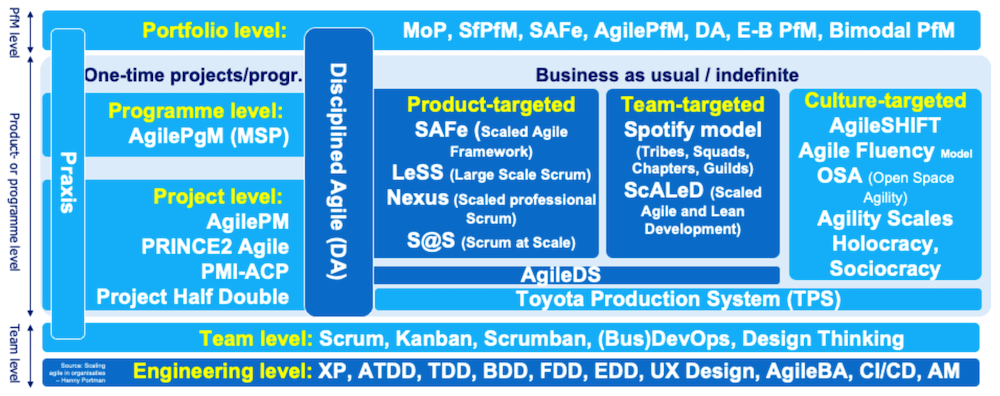
Thereby, Portman mapped out all Agile methodologies only used for software development in the dark blue box. Meanwhile, those in the light blue box can be popular in either IT or non-IT application development. Also, types of agile methodologies are positioned in different categories based on which level companies work on and how long projects last.
Of which, Scrum and Kanban prove the most prevalent methodologies with 84% of users, as surveyed by KPMG in 2019. These frameworks are considered the best basics to start with if companies plan for Agile transformation.
Top 6 Common Types of Agile Methodology You Should Know
Despite a wealth of Agile tools and frameworks, only some of them are widely used for projects of all kinds. In this section, Designveloper will focus on several most prevalent types of agile methodology that all project managers should know. These lightweight approaches work around the Agile Manifesto, hence showing some similarities. However, they have various features.
1. Scrum

Scrum is the most recognizable Agile framework by professionals, according to the 2019 survey by the Federal University of Technology in Paraná, Brazil.
This Agile framework enables companies to manage projects at a team level and conduct timeboxed tasks. Accordingly, the whole work will be split into small, manageable chunks that are carried out in a flexible order of priority. Each iteration, or called sprint, often lasts from one to four weeks with the involvement of the product owner, the Scrum Master, and developers.
This PM solution is considered suitable for the first stage of the product life cycle. Particularly, when companies plan to launch a new product for the first time, uncertainty and competitiveness are high. So to mitigate unexpected consequences (e.g. user dissatisfaction or failure to compete), teams target on-time delivery and quick feedback from customers. Scrum is among the best options for Agile teams to work on the core functionalities of deliverables and release them early in the market.
Recommended reading: Project Estimation: An Important Step before Starting Every Software Project
2. Kanban
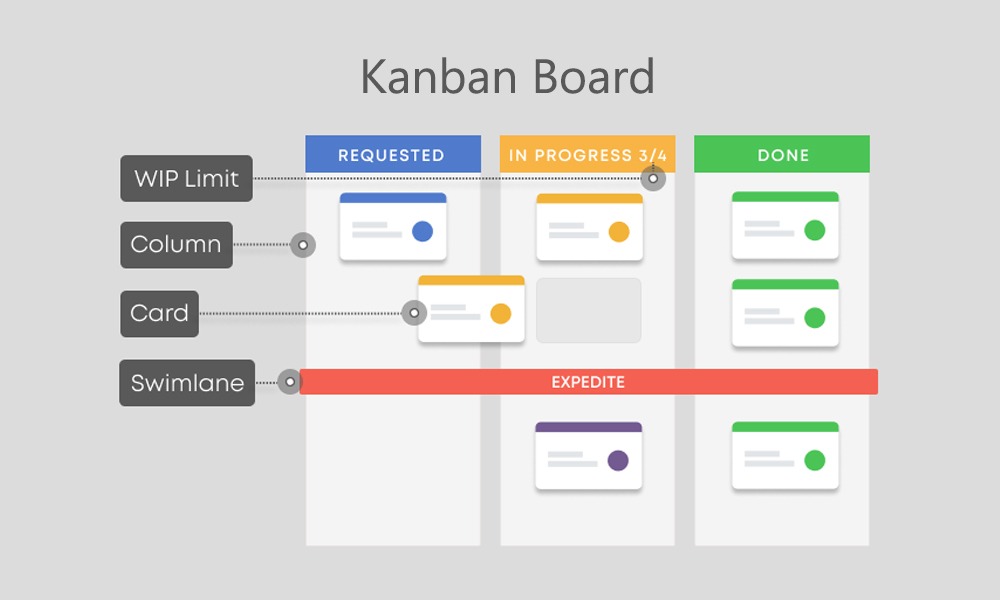
Kanban is another fundamental Agile framework that teams should consider if they want to visualize their workflow. Using physical cardboard or software, teams organize manageable pieces of work in named columns (i.e. To Do, In Progress, and Done). This allows teams to track where each item of work is located in the workflow.
Described as a team-level PM approach by Portman, Kanban is still widely adopted at other levels because teams working on Kanban mainly focus on making work in process (WIP) as small as possible. Teams optimize the product development process to minimize the average time to complete a task (or called the “lead time”).
Kanban mostly drives teams toward limited WIP rather than commitments to iterations. So teams can make good use of the framework when facing fewer changes and uncertain factors.
3. Extreme Programming (XP)
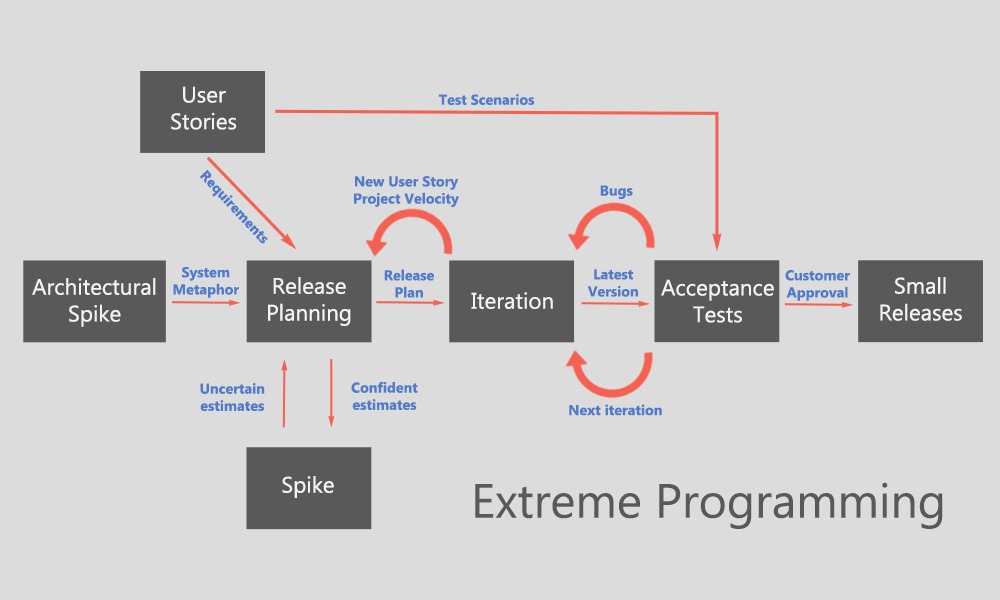
Like Scrum, Extreme Programming (XP) enables the project work to be implemented over short development timeframes, called “iterations”. Accordingly, it helps Agile teams adapt to changes in user requirements, even in the advanced stage of the product development cycle. And it also contributes to improvements in a product’s quality.
But what sets it apart from other types of Agile methodology is its main focus on technical aspects – that is, high-quality code. Accordingly, developers get instant feedback and improve their code by working in pairs and testing code (both manually and automatically). Project managers hold daily standup meetings to receive feedback on work progress and impediments. Meanwhile, product owners and other stakeholders base feedback on acceptance tests and a product’s performance in each iteration.
These traits of XP encourage productive teamwork and constant compliance with important rules to enhance code quality and deliverables.
4. Scaled-Agile Framework (SAFe)
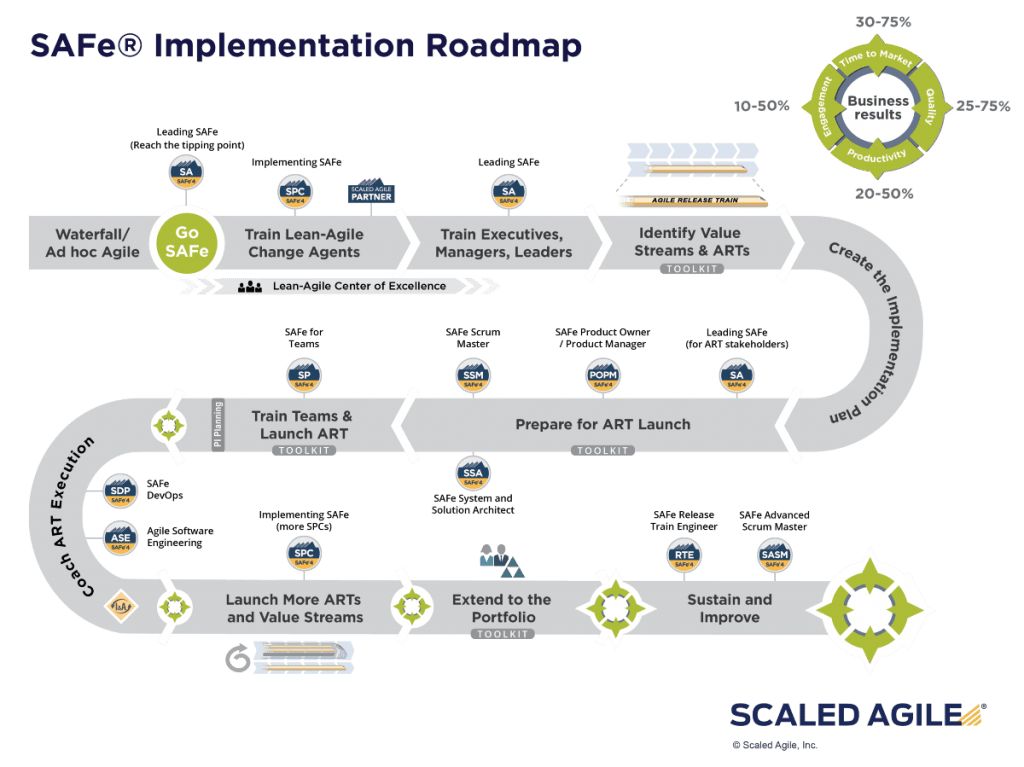
Once again, Scale-Agile Framework (SAFe) continues to become the most prevalent approach for scaling with 39% of users in 2021. This PM approach provides companies with guides, practices, and tools to streamline their development and operation processes at an enterprise level. One of the focal features of SAFe is an Agile Release Train which gathers multiple Agile teams sharing the same business and technology missions.
5. Scrum of Scrums (SoS)/ Scrum at Scale (S@S)
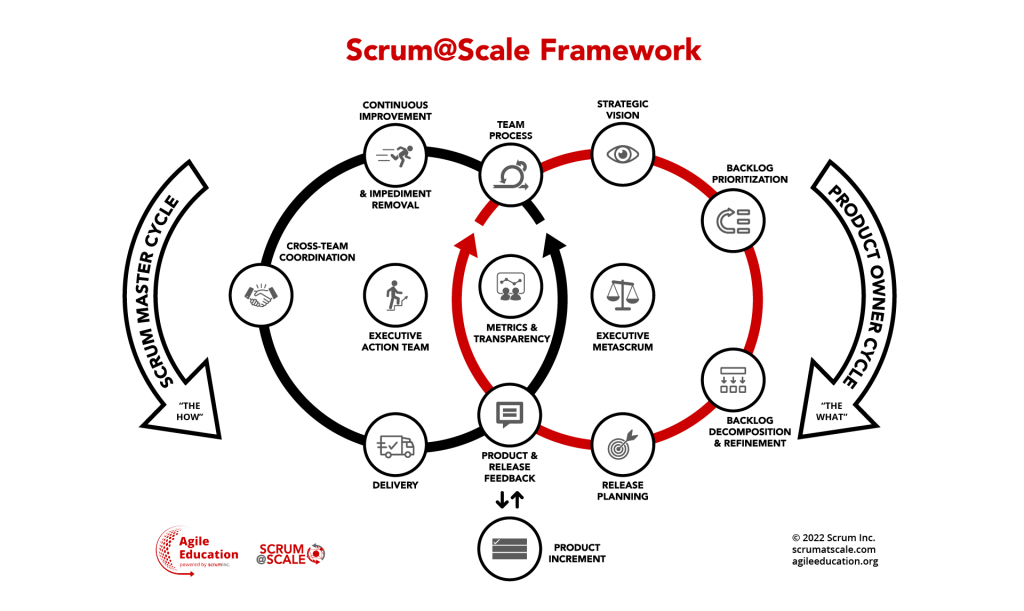
Recommended reading: Agile Sprint Cycle: Definition, Execution, and Steps Explained
Following SAFe, Scrum at Scale (S@S) is the second most widely used method for scaling organizations and projects. Based on fundamental Scrum principles, Jeff Sutherland (also the father of Scrum) and Alex Brown developed S@S that focuses on building a scaled network of Scrum teams to develop high-fidelity deliverables.
The flowchart above illustrates how important components are arranged in two key cycles: the Scrum Master Cycle and the Product Owner Cycle. These cycles are essential in defining “what” (the product) is created and “how” (the process) to develop it.
| FURTHER READING: |
| ▶ How to apply Scrum into your Software Development Company |
| ▶ The Importance of Scrum to a software product |
6. Spotify
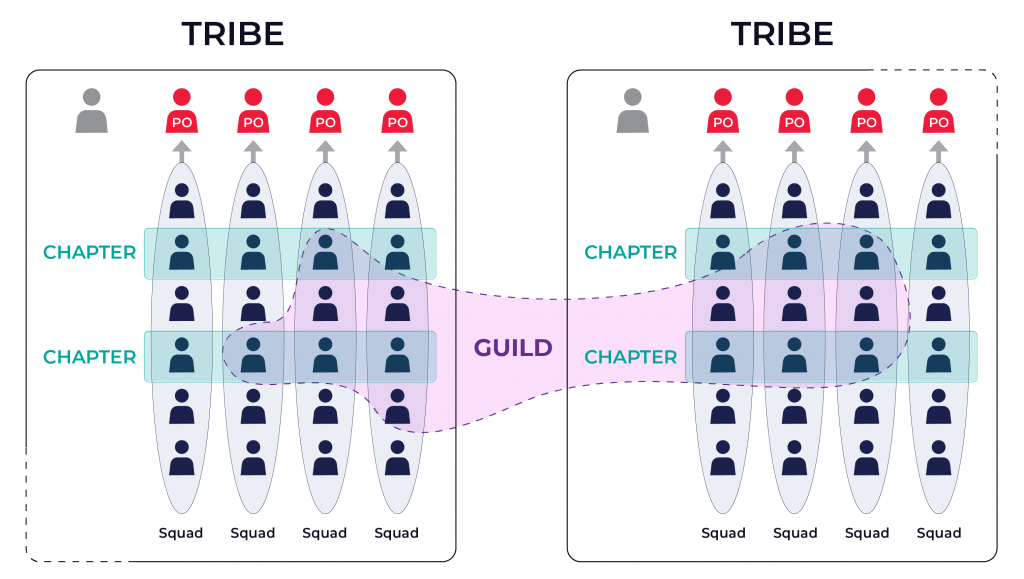
Spotify is an Agile scaling model that is successfully developed and applied in Spotify, the world’s largest audio streaming service provider. It’s a team-oriented model that drives multiple teams towards business agility by paying more importance to business culture and networks. Thereby, the Spotify methodology encourages companies to organize around work instead of performing certain practices.
From Spotify’s technical and cultural standpoints, teams will be autonomously structured into Squads, Tribes, Chapter, Guild, Trio, and Alliance.
Which Agile PM Approaches Fit Your Digital Transformation and Projects?
Agile project management is on-trend. This methodology is predicted to thrive in the future. This is attributable to digitalization which opens more avenues for changes and new trends. However, newcomers to Agile may find it confusing to choose the right framework for your business. So how can you select the most suitable Agile PM approach for your companies?
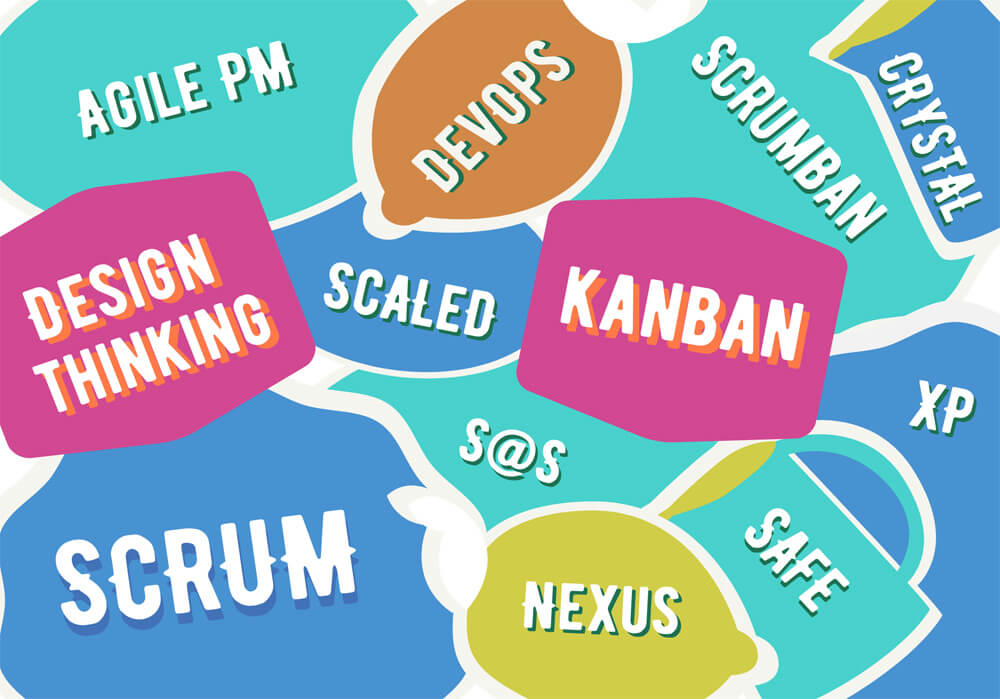
Recommended reading: 7 Software Project Management Methodologies Besides Agile
Your choice depends on various elements. To facilitate your selection of the proper PM solution, Designveloper suggests some important questions as follows:
- What is your Agile ambition? Every path to agility is different and challenging. So setting a strong goal and well-defined plan is advisable. Your Agile ambition should derive from your company’s practical needs instead of blindly following your competitor’s strategies. Also, you should realize how impactful Agile transition is for the company’s culture and operating model.
- Is your Agile ambition realistic? Becoming agile and developing enterprise-level agility are two different stories. Various leaders are under heavy pressure of making whole companies agile while they are in the kickoff phase of agility. The sound advice is they should start small and smart first with some basics (e.g. Scrum or Kanban) and then move organizations up to high-level agility.
- Which level does your company work on? As demonstrated by Portman, Agile methodologies are mapped out into three levels with Team Level as the most basic one. When companies scale up toward Product or Program Level and Portfolio levels, they will adopt extended or advanced versions of fundamental frameworks.
- Is the Agile PM approach adopted temporarily or frequently? Also according to Portman, some Agile methodologies developed from traditional PM analogs (i.e. AgilePM or PRINCE2 Agile) are primarily used for one-time projects. Meanwhile, for business-wide or long-term projects, Agile project management (PM) solutions can be based on your ultimate target (i.e. product, team, and culture).
| FURTHER READING: |
| ▶ Agile vs Traditional Project Management: Key Points in 2022 |
| ▶ Agile vs Scrum Methodology: Major Differences to Consider |
Designveloper’s Final Words
Today, whether to drive project work, albeit partial or entire, towards agility is no longer the common question for many organizations. Instead, when and how to implement that ambition provoke more concern among business leaders. There’s no the same path to business agility for all companies. Depending on your company’s strategic vision, goals, and other important metrics, your business can apply and customize standard frameworks.
But when going agile, multiple organizations confront existing challenges such as resistance to changes or inconsistencies in Agile practices. Therefore, no matter which types of Agile methodologies are applied, it’s advisable to develop the Agile mindset beforehand.
The post Top 6 Types of Agile Methodology to Consider in 2022 appeared first on Designveloper.
April 14, 2022 at 10:28AM













No comments:
Post a Comment